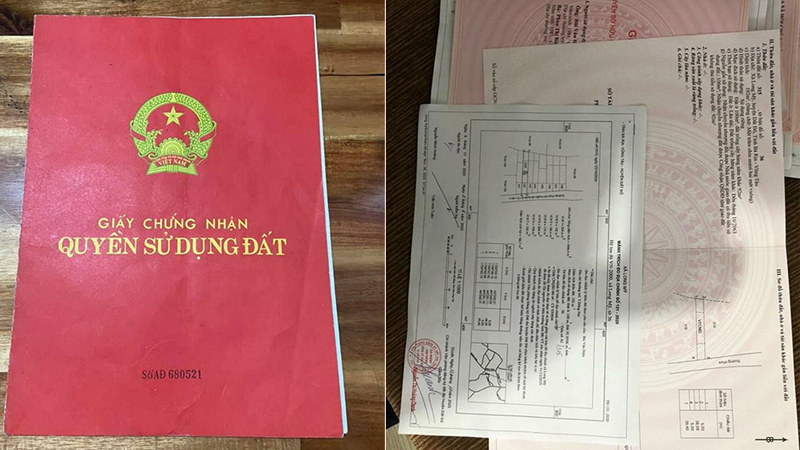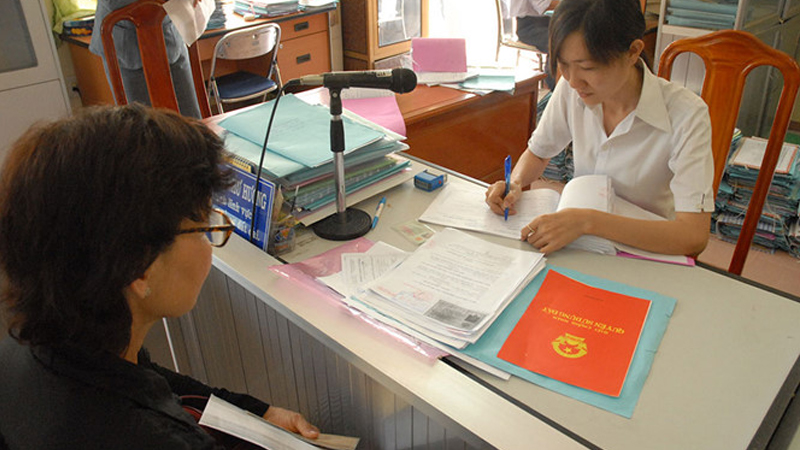Although it sounds familiar, the concept, as well as the legal nature and characteristics of the pink book and the red book, are not well understood by many people. Understanding this difficulty, today we provide detailed information about what the pink book and the red book are and their legal nature and characteristics.
1 What are the Pink Book and the Red Book?
First of all, it is necessary to understand that the “Red Book” is the common name for the “Land Use Rights Certificate”.
On the other hand, the Pink Book is the official name for the “Certificate of Home Ownership and Land Use Rights in Urban Areas” (inside cities, towns, and townships) issued to homeowners as stipulated by the Government’s Decree No. 60-CP dated July 5, 1994 on homeownership and land use rights in urban areas.
For convenience in daily life, people have referred to these certificates by their colors (red and pink) rather than their official names, as the law on land has never included the concepts of the “Pink Book” and the “Red Book.”
 The “Pink Book” and the “Red Book” now have a common name: “Certificate of Land Use Rights, Home Ownership, and other Assets attached to the Land”
The “Pink Book” and the “Red Book” now have a common name: “Certificate of Land Use Rights, Home Ownership, and other Assets attached to the Land”
In fact, since December 10, 2009, the “Pink Book” and the “Red Book” have been unified by the Ministry of Natural Resources and Environment under the name “Certificate of Land Use Rights, Home Ownership, and other Assets attached to the Land”.
2 Which is More Valuable: the Pink Book or the Red Book?
Currently, both the Pink Book and the Red Book have legal value, and this value is reflected in the recognized rights to the assets. In other words, the value of each type of book lies in the specific land lot, house, and other assets attached to the land, rather than in the book itself, as it is just a piece of paper recognizing those rights.
 It is impossible to determine whether the Pink Book or the Red Book is more valuable
It is impossible to determine whether the Pink Book or the Red Book is more valuable
3 Do I Need to Change the Red Book to the Pink Book?
As mentioned above, the Pink Book and the Red Book are both types of Land Use Rights Certificates, legally recognized, and of equal value. Therefore, there is no need to change from the Red Book to the Pink Book unless you have a specific need to do so.
The cases in which the Red Book can be changed to the Pink Book are stipulated in Clause 1, Article 76 of Decree 43/2014/ND-CP, which provides details on the implementation of several articles of the Land Law:
- Land users who need to change the Certificate of Home Ownership, the Certificate of Ownership of Construction Works, or other types of certificates issued before December 10, 2009.
- The Certificate of Ownership, the Certificate of Home Ownership, or the Certificate of Ownership of Construction Works is faded, blurred, torn, or damaged.
- Cases involving land consolidation, land swapping, or measurement to determine the area or size of the land.
- Cases where the Land Use Rights, Ownership of Assets attached to the Land, are jointly owned by a couple, and the Certificate of Ownership is registered under the name of either the husband or the wife, and there is a request to change the certificate to include the names of both spouses.
4 Requirements for Obtaining the Red Book
The requirements for obtaining the Land Use Rights Certificate may vary depending on the specific land lot because each lot has a different origin and status of land use.
According to Article 100, 101 of the 2013 Land Law and Article 20, 21, 22, 23 of Decree 43/2014/ND-CP, the requirements for obtaining the certificate fall into two main cases:
-
Case 1: Having documents on land use rights as stipulated in Article 100 of the 2013 Land Law and Article 18 of Decree 43/2014/ND-CP.
-
Case 2: Not having documents on land use rights (most of the land lots currently used by households and individuals that have not been granted the certificate for the first time fall into this case).
 People queue to apply for the Red Book
People queue to apply for the Red Book
5 Application File and Procedures for Obtaining the Red Book for the First Time
Application File for Obtaining the Land Use Rights Certificate for the First Time
According to Clause 1, Article 8 of Circular No. 24/2014/TT-BTNMT, households and individuals must prepare one set of application documents with the following types of papers:
-
Application for registration and granting of the certificate according to Form No. 04a/ĐK.
-
Documents proving the fulfillment of financial obligations; papers related to the exemption or reduction of financial obligations for land and assets attached to the land (if any)
In addition to the two types of papers mentioned above, depending on the specific case, other documents may be required to prove the Land Use Rights or the Ownership of Assets attached to the Land, as follows:
-
For cases of registering Land Use Rights, submit one of the types of papers stipulated in Article 100 of the 2013 Land Law and Article 18 of Decree 43/2014/ND-CP.
-
For cases of registering the Ownership of Assets attached to the Land, submit documents proving the ownership of those assets (usually, the asset to be registered is a house)
 Nowadays, there are also many Red Book application services
Nowadays, there are also many Red Book application services
For cases of registering the Ownership of Housing or Construction Works, submit a diagram of the house or construction work (unless the diagram of the house or construction work, consistent with the current status of the built house or construction work, is included in the papers on the ownership of the house or construction work).
Note: According to Clause 9, Article 7 of Circular No. 33/2017/TT-BTNMT, applicants can choose to submit either the original or a copy of the papers, as follows:
-
Submit a copy of the papers that have been notarized or certified as stipulated by the law on notarization and certification.
-
Submit a copy of the papers and present the original for comparison and confirmation by the official receiving the application file.
-
Submit the original papers.
Procedures for Obtaining the Land Use Rights Certificate for the First Time
Step 1. Submit the Application File
Method 1: Households and individuals submit the application file at the People’s Committee of the commune, ward, or town where the land is located if they wish to do so.
Method 2: Do not submit the application file at the People’s Committee of the commune, ward, or town:
-
If the locality has not established a one-door division, households and individuals submit the application file at the Branch of the District-level Land Registration Office or the District-level Land Use Rights Registration Office in places where the Branch of the Land Registration Office has not been established.
-
For localities that have established a one-door division to receive and return results of administrative procedures, submit the application file at the one-door division at the district level.
Step 2. The Department of Natural Resources and Environment of the district-level People’s Committee receives the application file.
Step 3. Process the request.
In this step, applicants only need to pay attention to the following issue:
-
Upon receiving the notification from the tax department, households and individuals must pay the amounts specified in the notification, such as the Land Use Rights Certificate fee, land use fee (if any), registration fee, and dossier evaluation fee (if any).
-
After making the payment, keep the receipts as proof of having fulfilled the financial obligations and present them when receiving the certificate.
Note: The certificate will be issued only after all the amounts have been paid, except in cases where the land use fee is recorded as a debt.
 Obtaining the Land Use Rights Certificate for the first time
Obtaining the Land Use Rights Certificate for the first time
Step 4. At the appointed time, citizens bring the appointment slip to the District-level Land Use Rights Registration Office to receive the results.
According to Article 4 of Decree 45/2014/ND-CP and Decree 43/2014/ND-CP, which provides details on a number of articles of the Land Law:
Land use fee to be paid = Land price for calculating the land use fee according to the purpose of land use x Area of land subject to land use fee – Land use fee reduction as stipulated in Article 12 of this Decree (if any) – Land compensation and clearance costs to be deducted from the land use fee (if any)
6 Frequently Asked Questions about the Pink Book and the Red Book
How Long Does It Take to Obtain the Red Book?
According to Clause 40, Article 2 of Decree 01/2017/ND-CP, the time limit for handling the application is as follows:
No more than 30 days from the date of receipt of a valid application file; no more than 40 days for communes in mountainous, island, remote, or difficult socio-economic conditions.
The above time limit does not include weekends, holidays, the time for receiving the application file at the commune level, the time for fulfilling financial obligations, the time for handling cases of land use violations, or the time for expert appraisal.
Are the Costs of Obtaining the Red Book for Different Land Lots the Same?
The costs of obtaining the Land Use Rights Certificate for the first time vary depending on the specific land lot, such as whether the land lot has papers on land use rights, its area, origin, type, etc.
Case 1: Having one of the papers on land use rights as stipulated in Clause 1, Article 100 of the 2013 Land Law
If households and individuals have papers on land use rights as stipulated in Clause 1, Article 100 of the 2013 Land Law and Article 18 of Decree 43/2014/ND-CP and have been using the land stably, they do not have to pay the land use fee. In this case, they only have to pay the registration fee, the Land Use Rights Certificate fee, and the dossier evaluation fee (only a few provinces collect this fee).
Case 2: Not having papers on land use rights
In this case, you may have to pay the following four types of fees:
-
Land use fee.
-
Registration fee when the certificate is granted.
-
Dossier evaluation fee for granting the certificate.
-
Land Use Rights Certificate fee.
































